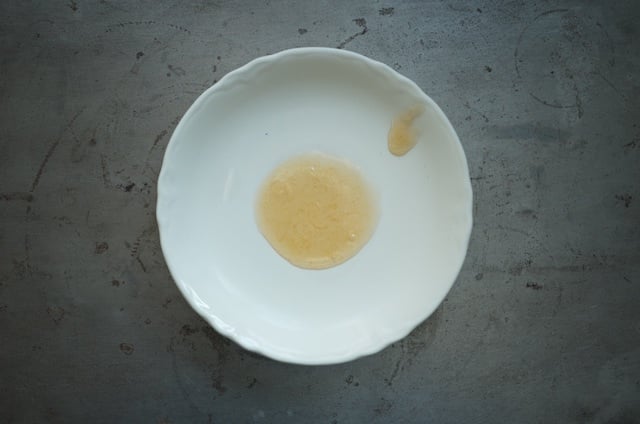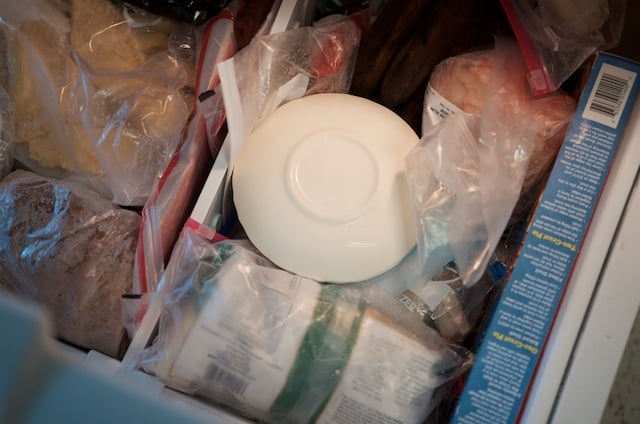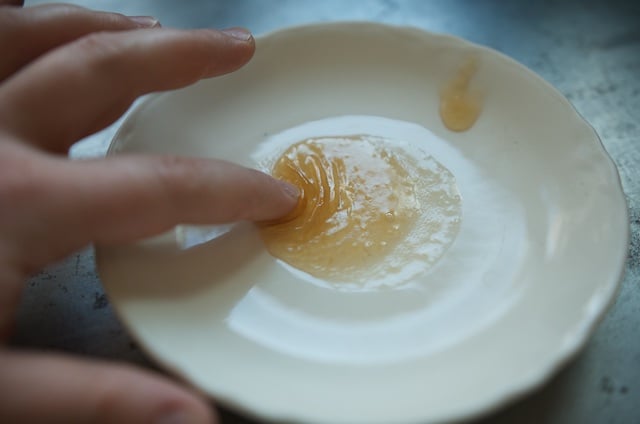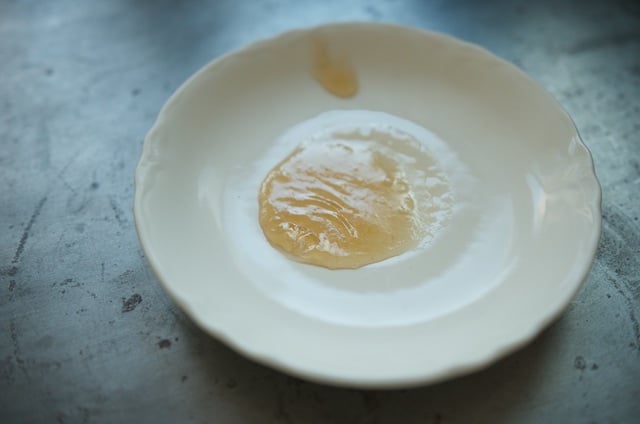
One thing I heard from a bunch of folks as they made their marmalade for the Mastery Challenge was that they struggled to find the set point. And I get it. Determining when you’ve hit the set point for jams, jellies, and marmalades can be kind of tricky, particularly if you don’t have a lot of batches under your belt.
You’ve got temperature, which is reliable most of the time, except when it isn’t (thermometers aren’t perfect and often they need to be calibrated). You can watch how the preserve sheets off the spoon or spatula, but what if you don’t know what you’re looking for? If you found yourself asking these questions as your made your marmalade, the plate test is for you.
Also known as the freezer test or the saucer test, this is a method of checking for set that requires some pre-planning. You need to stash a couple small bowls, plates, or saucers in your freezer before you start cooking the marmalade, so that they’ll be nice and cold when you’re nearing the end of the cooking process.
When you hit the point when you think the marmalade is finished, you remove the pot from the heat and dollop a spoonful of marmalade onto the frozen plate. Then, you return the plate to the freezer for a few minutes. This accelerates the setting process and gives you a peek into the future of your marmalade.
After those few minutes are up, you pull that plate out of the freezer and give the dollop of marmalade a nudge with the tip of your finger. If a set has begun to form, it will wrinkle when you push it (as demonstrated in the picture above). If that’s the case, it is done. If the marmalade hasn’t set, your finger will slide right through the dollop and you’ll need to cook the marmalade a bit longer.
Do take care to pull the pot off the heat while you’re running this test. If you let the preserve continue to cook while you’re waiting to see if it’s going to set up, you run the very real risk of overcooking and scorching.





And what’s the maximum amount of liquid you can safely use?
There is no one maximum. It mostly depends on the size of your pan.
Okaaay… Thanks! How do manufacturers do it?
They use very large, wide pots (the ratio of surface area to depth is key here. As long as you have a lot of surface area and not a lot of depth, you’ll be able to reach the set point). They also use very high levels of sugar and pectin to ensure a set.
Does the size of your batch make a difference? I get a gelling point with smaller batches, but with large batches I could boil to that greasy-looking rolling boil and have the thermometer show 105C without ever getting it to gel.
Yes. The larger the batch, the harder it is to reach the set point. I write about doubling and large batch sizes here: https://foodinjars.com/blog/canning-101-why-you-shouldnt-double-batches-of-jam/
Oh! I didn’t know either that you were supposed to put it back in the freezer! I tested, and tested, and tested, and it never started to set or wrinkle on the plate for me. Even though the temperature was right. I was making blood orange marmalade so I got desperate and put in some powdered pectin. Well, it’s a bit hard, but the flavor is there. Then, tonight, my daughter noticed that two of the ‘reusable’ lids were loose! This has never happened to me with those lids before.
I have a question about the plate test. When you push it and it wrinkles, should it then spread back out or no?
I finally got my courage back up to try marmalade again this year after many past failures, and while this batch of blood orange marmalade certainly is at least edible (hooray!), I think it somehow managed to go past the gel point. I used a thermometer, I used a plate, I watched those drips like a hawk (never did look right), and I think I managed to overcook it. At least it didn’t scorch, I guess.
It seems so wrong to use pectin in marmalade, but whenever I try to make preserves without, they never, ever set up correctly, even if it’s fruit that’s full of pectin, like citrus or quince.
It should spread back out. You will probably see some echo of the wrinkles, but if it stays exactly where you put it when you pushed it, it’s probably overcooked. The thing you’re looking for is the presence of the skin forming on the surface of the preserve. That’s what’s indicating that it’s going to set.
Thanks so much for answering my question!
Back to the drawing board, then.
I’m wondering if I’m bringing my marmalade up to temperature too fast? Is that a thing? Because I’m definitely not ever getting any kind of gelling. It never sheets and there’s never any kind of skin on the freezer samples, and I never get that amazing set in the pot that you show in your pictures. I do have a glass top stove (unfortunately), and it does bring things to a boil awfully fast.
There must be something I’m missing, and it’s driving me crazy. I know what to look for, but it never happens!
Huh. I’ve never heard of rapid boiling becoming a problem. Are you certain that your thermometer is calibrated correctly? Oh, and what elevation are you at? That impacts the temperature to which you cook it to achieve a set.
I’m at like ~850ft, so I don’t think that should make a huge difference?
But in any case, if I’m overcooking, shouldn’t that mean I’m passing the gel point? It got super dark (and is completely hardened in the jar) without ever showing any of the signs of gelling. No sheeting, no glossy look, no skin formation in the freezer or when I took the pot off the stove.
I put down earlier failures to pectin problems, but now that I’ve had issues with two pectin-rich fruits, there’s clearly something going awry, and I just have no idea what it is.
Your elevation shouldn’t have an impact. If it’s overcooking, you should be passing the set point. I don’t quite know how it’s possible to be passing the set point and not actually get a set, though. I am confounded.
Ah ha! I didn’t understand we were to put the plate with marmalade BACK into the fridge to check after a few minutes. After completing the test with frozen plate and it not being set, I left the pot on the stove, saw that it was beginning to scorch and quickly removed it. End result, taste is good but there are a few flecks of unwanted dark spots resulting from me unknowingly stirring from the bottom of the pot. I’ll be ready next time!
Thank you for the pictures. I too learn from visuals.
thank you for the pictures! while i’ve read about and used this technique, it’s great to have visuals to go with it.